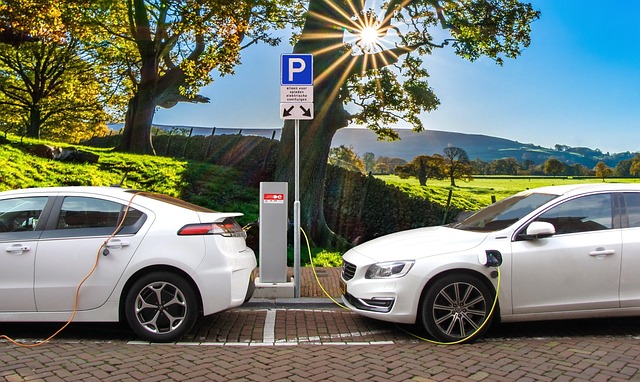Looking to register your car in California? This comprehensive guide breaks down the process step-by-step. From understanding key requirements to acquiring necessary documents, this article ensures a smooth experience. Learn how to perform a DMV VIN verification, complete applications, and pay fees efficiently. By following these straightforward instructions, you’ll have your vehicle registered in no time, ensuring legal compliance and peace of mind on California’s roads.
- Understand California Car Registration Requirements
- Gather Necessary Documents for DMV Visit
- Perform VIN Verification: Step-by-Step Guide
- Complete Application and Pay Fees at DMV
- Obtain License Plate and Register Your Vehicle
Understand California Car Registration Requirements

Before registering your car in California, it’s crucial to understand the state’s specific requirements. The California Department of Motor Vehicles (DMV) mandates several steps for new and existing vehicle owners alike. One essential step is the DMV VIN verification process, which ensures that all vehicles on California roads meet safety standards. This involves checking the vehicle’s identification number (VIN) to confirm its authenticity and history.
A key component of this process is ensuring your car has a valid and clean title. Additionally, you’ll need to pass an emissions test and have your vehicle inspected by an authorized facility. For convenience, many residents opt for mobile VIN verifiers or services that perform these inspections at your location, streamlining the registration process significantly.
Gather Necessary Documents for DMV Visit

Before heading to the California DMV, make sure you have all the required documents for a smooth registration process. The key documents include your vehicle’s registration certificate from the previous state, proof of insurance, and identification such as a driver’s license or passport. Additionally, you’ll need to undergo a DMV VIN verification process, which requires providing the Vehicle Identification Number (VIN) of your car. This step is crucial for ensuring the vehicle’s history is accurately checked.
For convenience, many individuals opt for a mobile vin inspection or mobile vin verification service, allowing them to complete this part of the process from the comfort of their homes. By having all these documents readily available, you’ll be well-prepared to navigate the registration process efficiently and avoid any potential delays.
Perform VIN Verification: Step-by-Step Guide

Performing a VIN (Vehicle Identification Number) verification is a crucial step in the car registration process in California. This process ensures that your vehicle’s history is accurate and helps prevent fraud. The California DMV provides guidelines for this procedure, which can be done through a traditional vin inspection or, conveniently, with a mobile vin verification service.
Here’s a simple step-by-step guide:
1. Obtain your car’s VIN from the vehicle registration documents or by locating it on the driver’s side of the dashboard. It’s a unique 17-character code.
2. Decide between a traditional inspection at a DMV office (or authorized agent) or using a mobile vin inspection service that can often be done right at your location.
3. During the verification, an inspector will cross-reference the VIN with various databases to check for any reported issues, accidents, or outstanding loans on the vehicle.
4. Once complete, if there are no discrepancies, you’ll receive confirmation allowing you to proceed with car registration. If issues arise, you may need to resolve them before continuing.
Complete Application and Pay Fees at DMV

After gathering all necessary documents, it’s time to complete your car registration process at a California Department of Motor Vehicles (DMV) office. You’ll need to fill out Form MV-5, which is the Application for Title and Registration. This form requires detailed information about you, the vehicle owner, and your vehicle, including its make, model, year, and unique Vehicle Identification Number (VIN).
Once your application is complete, you’ll be directed to the fee counter where you must pay the required registration fees. These fees vary based on the type of vehicle and other factors. Ensure you also undergo a DMV VIN verification process to validate your car’s identity and history, which can be efficiently completed through a mobile vin verifier or mobile vin inspection service, making the entire process more convenient for California residents.
Obtain License Plate and Register Your Vehicle

After completing your vehicle’s purchase, the next step in California is to obtain a license plate and register your car with the Department of Motor Vehicles (DMV). Before registering, you’ll need to undergo a DMV VIN verification process to ensure that your vehicle meets all safety and emission standards. This can be done online or at a local DMV field office.
For convenience, many California residents opt for a mobile VIN inspection service where a verifier will come to their location to perform the necessary checks, including verifying the Vehicle Identification Number (VIN) and inspecting the vehicle for any outstanding issues. This streamlined approach saves time and effort, making it an attractive option for busy individuals who still want to ensure compliance with DMV regulations.
Registering a car in California involves understanding specific requirements, gathering essential documents, and completing crucial processes like VIN verification through the DMV. By meticulously following these steps—from preparation to obtaining your license plate—you’ll ensure your vehicle is legally registered and ready to hit the bustling California roads. Remember, proper registration is not just a legal obligation but also ensures your safety and that of other drivers.
